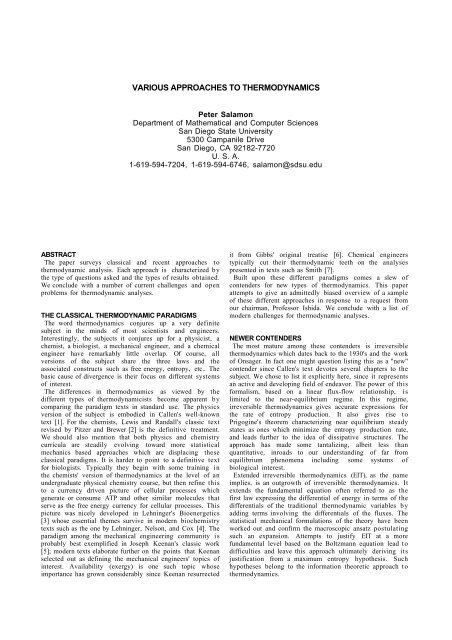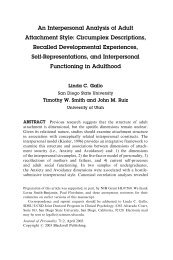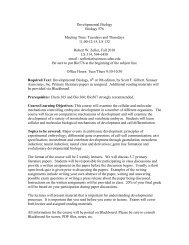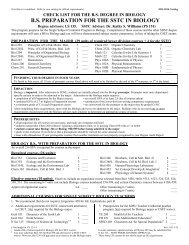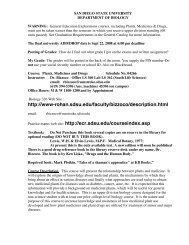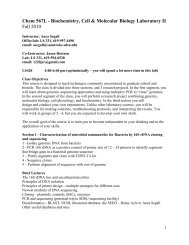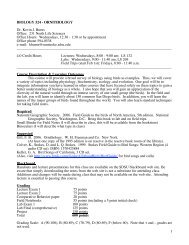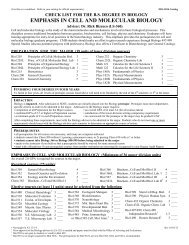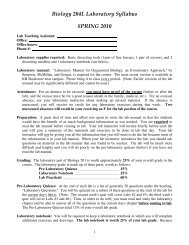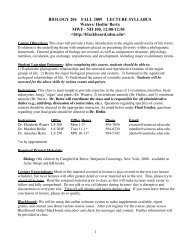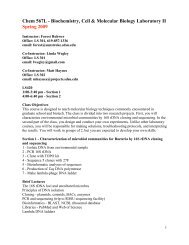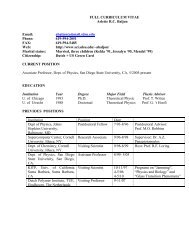various approaches to thermodynamics - San Diego State University
various approaches to thermodynamics - San Diego State University
various approaches to thermodynamics - San Diego State University
You also want an ePaper? Increase the reach of your titles
YUMPU automatically turns print PDFs into web optimized ePapers that Google loves.
VARIOUS APPROACHES TO THERMODYNAMICS<br />
Peter Salamon<br />
Department of Mathematical and Computer Sciences<br />
<strong>San</strong> <strong>Diego</strong> <strong>State</strong> <strong>University</strong><br />
5300 Campanile Drive<br />
<strong>San</strong> <strong>Diego</strong>, CA 92182-7720<br />
U. S. A.<br />
1-619-594-7204, 1-619-594-6746, salamon@sdsu.edu<br />
ABSTRACT<br />
The paper surveys classical and recent <strong>approaches</strong> <strong>to</strong><br />
thermodynamic analysis. Each approach is characterized by<br />
the type of questions asked and the types of results obtained.<br />
We conclude with a number of current challenges and open<br />
problems for thermodynamic analyses.<br />
THE CLASSICAL THERMODYNAMIC PARADIGMS<br />
The word <strong>thermodynamics</strong> conjures up a very definite<br />
subject in the minds of most scientists and engineers.<br />
Interestingly, the subjects it conjures up for a physicist, a<br />
chemist, a biologist, a mechanical engineer, and a chemical<br />
engineer have remarkably little overlap. Of course, all<br />
versions of the subject share the three laws and the<br />
associated constructs such as free energy, entropy, etc.. The<br />
basic cause of divergence is their focus on different systems<br />
of interest.<br />
The differences in <strong>thermodynamics</strong> as viewed by the<br />
different types of thermodynamicists become apparent by<br />
comparing the paradigm texts in standard use. The physics<br />
version of the subject is embodied in Callen's well-known<br />
text [1]. For the chemists, Lewis and Randall's classic text<br />
revised by Pitzer and Brewer [2] is the definitive treatment.<br />
We should also mention that both physics and chemistry<br />
curricula are steadily evolving <strong>to</strong>ward more statistical<br />
mechanics based <strong>approaches</strong> which are displacing these<br />
classical paradigms. It is harder <strong>to</strong> point <strong>to</strong> a definitive text<br />
for biologists. Typically they begin with some training in<br />
the chemists' version of <strong>thermodynamics</strong> at the level of an<br />
undergraduate physical chemistry course, but then refine this<br />
<strong>to</strong> a currency driven picture of cellular processes which<br />
generate or consume ATP and other similar molecules that<br />
serve as the free energy currency for cellular processes. This<br />
picture was nicely developed in Lehninger's Bioenergetics<br />
[3] whose essential themes survive in modern biochemistry<br />
texts such as the one by Lehninger, Nelson, and Cox [4]. The<br />
paradigm among the mechanical engineering community is<br />
probably best exemplified in Joseph Keenan's classic work<br />
[5]; modern texts elaborate further on the points that Keenan<br />
selected out as defining the mechanical engineers' <strong>to</strong>pics of<br />
interest. Availability (exergy) is one such <strong>to</strong>pic whose<br />
importance has grown considerably since Keenan resurrected<br />
it from Gibbs' original treatise [6]. Chemical engineers<br />
typically cut their thermodynamic teeth on the analyses<br />
presented in texts such as Smith [7].<br />
Built upon these different paradigms comes a slew of<br />
contenders for new types of <strong>thermodynamics</strong>. This paper<br />
attempts <strong>to</strong> give an admittedly biased overview of a sample<br />
of these different <strong>approaches</strong> in response <strong>to</strong> a request from<br />
our chairman, Professor Ishida. We conclude with a list of<br />
modern challenges for thermodynamic analyses.<br />
NEWER CONTENDERS<br />
The most mature among these contenders is irreversible<br />
<strong>thermodynamics</strong> which dates back <strong>to</strong> the 1930's and the work<br />
of Onsager. In fact one might question listing this as a "new"<br />
contender since Callen's text devotes several chapters <strong>to</strong> the<br />
subject. We chose <strong>to</strong> list it explicitly here, since it represents<br />
an active and developing field of endeavor. The power of this<br />
formalism, based on a linear flux-flow relationship, is<br />
limited <strong>to</strong> the near-equilibrium regime. In this regime,<br />
irreversible <strong>thermodynamics</strong> gives accurate expressions for<br />
the rate of entropy production. It also gives rise <strong>to</strong><br />
Prigogine's theorem characterizing near equilibrium steady<br />
states as ones which minimize the entropy production rate,<br />
and leads further <strong>to</strong> the idea of dissipative structures. The<br />
approach has made some tantalizing, albeit less than<br />
quantitative, inroads <strong>to</strong> our understanding of far from<br />
equilibrium phenomena including some systems of<br />
biological interest.<br />
Extended irreversible <strong>thermodynamics</strong> (EIT), as the name<br />
implies, is an outgrowth of irreversible <strong>thermodynamics</strong>. It<br />
extends the fundamental equation often referred <strong>to</strong> as the<br />
first law expressing the differential of energy in terms of the<br />
differentials of the traditional thermodynamic variables by<br />
adding terms involving the differentials of the fluxes. The<br />
statistical mechanical formulations of the theory have been<br />
worked out and confirm the macroscopic ansatz postulating<br />
such an expansion. Attempts <strong>to</strong> justify EIT at a more<br />
fundamental level based on the Boltzmann equation lead <strong>to</strong><br />
difficulties and leave this approach ultimately deriving its<br />
justification from a maximum entropy hypothesis. Such<br />
hypotheses belong <strong>to</strong> the information theoretic approach <strong>to</strong><br />
<strong>thermodynamics</strong>.
The information theoretic formulation of <strong>thermodynamics</strong><br />
became a definitive paradigm in the now classic papers by<br />
Jaynes [8]. This formulation has had many successes outside<br />
traditional <strong>thermodynamics</strong> as attested by the annual<br />
MaxEnt conferences, the nineteenth of which, Maxent99, will<br />
be held this August in Boise, Idaho [9]. The information<br />
theoretic approach has also led <strong>to</strong> important work within the<br />
traditional domain of <strong>thermodynamics</strong> problems, notably in<br />
chemical physics where it has led <strong>to</strong> the notions of different<br />
temperatures for different degrees of freedom (vibrational,<br />
rotational, translational, spin) and has been an important<br />
<strong>to</strong>ol for analyzing nascent product distributions in chemical<br />
dynamics.<br />
One important lesson from both EIT and the information<br />
theoretic approach concerns the idea of separability of time<br />
scales in a process. Basically, this idea assures us that when<br />
different processes in a system occur on widely different time<br />
scales, then a thermodynamic description which treats some<br />
degrees of freedom as completely equilibrated (fast) and<br />
others as completely frozen (slow) can give an accurate<br />
description of the process on intermediate time scales. This<br />
is how we arrive at, say vibrational temperature for processes<br />
in which the vibrational energy is separately conserved. In<br />
fact, the idea of time scales is crucial in any thermodynamic<br />
description, since we always ignore certain degrees of<br />
freedom as being <strong>to</strong>o slow <strong>to</strong> be of interest, e.g. nuclear<br />
transitions at room temperature in most materials. As pointed<br />
out in Tolman's classic monograph [10], without this<br />
assumption, all equilibrium systems would be composed<br />
mostly of Fe56. Recent progress in singular perturbation<br />
theory has shown how <strong>to</strong> improve on the thermodynamic<br />
description when the time scales are only weakly separable<br />
[11].<br />
The <strong>approaches</strong> above have come primarily from physics<br />
and chemistry. The biological version of the subject has<br />
evolved steadily but this evolution has merely supplied the<br />
detail required for an accurate quantitative understanding of<br />
energetics in biological systems. While a comparison of<br />
Lehninger's 1970 biochemistry book [12] with his 1994<br />
book [4] reveals tremendous progress, new syntheses are<br />
lacking. Such new syntheses are likely <strong>to</strong> come soon,<br />
however, as foreshadowed by the recent success of the<br />
quantum mechanical description of pho<strong>to</strong>synthesis in<br />
purple bacteria. In addition, our ability <strong>to</strong> experimentally<br />
manipulate these systems has improved greatly and this<br />
offers another omen of great strides <strong>to</strong> come.<br />
Before proceeding <strong>to</strong> new <strong>approaches</strong> related <strong>to</strong> engineering<br />
<strong>thermodynamics</strong>, we pause <strong>to</strong> mention a school of<br />
<strong>thermodynamics</strong> that has emerged primarily from<br />
mathematics departments. The approach is known as rational<br />
<strong>thermodynamics</strong> [13] and has as its primary concern the<br />
problem of finding a rigorous axiomatic framework that can<br />
accommodate complex thermodynamic systems such as milk<br />
and concrete. While these formulations have added some<br />
insight in<strong>to</strong> the mathematical structure of the<br />
thermodynamic formalism, better progress has been made in<br />
our understanding of the <strong>thermodynamics</strong> of complex<br />
systems from the work of the chaos / nonlinear dynamics<br />
community using the <strong>to</strong>ols of statistical mechanics.<br />
Progress in engineering <strong>thermodynamics</strong> has come<br />
primarily from the approach known as exergy analysis. This<br />
approach has been successful at forging reliable <strong>to</strong>ols <strong>to</strong><br />
quantify detailed analyses of exergy degradation in a plant.<br />
Such analyses can pinpoint potential savings and how such<br />
savings can be achieved. A similar, though much less<br />
demanding approach <strong>to</strong> energy integration in plant<br />
operations is known as pinch analysis. The basic problem<br />
considered in this approach is how <strong>to</strong> combine heating and<br />
cooling demands in a way that minimizes the use of<br />
additional sources and sinks.<br />
In this context, we mention also the <strong>approaches</strong> of<br />
thermoeconomics [14] and exergoeconomics [15]. These<br />
schools of thought carry out analyses which blend the<br />
economic and the thermodynamic variables <strong>to</strong> understand<br />
problems such as global economic policy and chemical plant<br />
design respectively.<br />
Finally we come <strong>to</strong> a group of <strong>approaches</strong> which we will call<br />
control <strong>thermodynamics</strong>. Included in this group is finitetime<br />
<strong>thermodynamics</strong> [14] and entropy generation<br />
minimization[16]. These <strong>approaches</strong> were left for last in part<br />
because the blending of control ideas and <strong>thermodynamics</strong> is<br />
the author's candidate for major progress in the near future.<br />
The basic question concerns the characterization of what is<br />
achievable during the control of a thermodynamic process.<br />
Note that this is a natural extension of that portion of<br />
traditional <strong>thermodynamics</strong> which deals with reversible<br />
processes: the ultimate bounds <strong>to</strong> what can be achieved. Note<br />
further that systems in which some agent exercises control of<br />
the process include biological systems, computing systems,<br />
and engineering systems. Reversible control is usually<br />
excluded by the demand that the process take place at a finite<br />
rate using finite resources.<br />
The name control <strong>thermodynamics</strong> originated with Ana<strong>to</strong>ly<br />
Tsirlin's work [17] exploring the optimal control of<br />
thermodynamic processes. Criticisms voiced at ECOS'98 for<br />
the name finite-time <strong>thermodynamics</strong> were convincing.<br />
Michel Feidt suggested that something closer <strong>to</strong> finite<br />
resource <strong>thermodynamics</strong> might be more a propos. While<br />
Adrian Bejan's name of entropy generation minimization is<br />
another possible candidate, this name misses a large part of<br />
the potential control space admissible for many interesting<br />
problems. For example, it misses the difference between<br />
minimum entropy production operation and maximum power<br />
operation for a process. In summary, we advocate adopting<br />
Tsirlin's name of control <strong>thermodynamics</strong> for this family of<br />
<strong>approaches</strong>.<br />
Note an important difference between control<br />
<strong>thermodynamics</strong> and the other <strong>approaches</strong> described above.<br />
In control <strong>thermodynamics</strong>, the aim is not <strong>to</strong> describe what<br />
happens but what might possibly happen. The immediate<br />
next question is: how much does it cost <strong>to</strong> make a<br />
thermodynamic process proceed at a certain finite rate? We<br />
conclude by mentioning a debate in this community<br />
concerning the extent <strong>to</strong> which <strong>various</strong> irreversibilities must<br />
be counted. The engineering members would insist that all<br />
irreversibilities be counted [18], while the science members<br />
(the present author among them) would argue that <strong>to</strong><br />
understand each mode of exergy degradation, it is best <strong>to</strong><br />
shut off all but one or at most a few modes and see what can<br />
be achieved.<br />
SOME CURRENT CHALLENGES<br />
We conclude this survey of <strong>approaches</strong> <strong>to</strong> <strong>thermodynamics</strong><br />
by listing some current challenges <strong>to</strong> thermodynamic<br />
analysis. The problem of finding thermodynamic<br />
characterizations of living systems has been with us for a few<br />
generations but it is only now that sufficiently detailed<br />
information is pouring in. In fact, the accellerating rate of<br />
progress in most fields of science and engineering poses<br />
numerous challenges <strong>to</strong> thermodynamic understanding. For<br />
example, the achievement of ultra low (nanokelvin)
temperatures using a<strong>to</strong>m s<strong>to</strong>pping techniques poses a<br />
challenge <strong>to</strong> heat engine theory <strong>to</strong> provide a thermodynamic<br />
analysis of such cooling and <strong>to</strong> predict limits <strong>to</strong> the<br />
efficiency with which such cooling can be carried out. In the<br />
field of chemical <strong>thermodynamics</strong>, the big challenges are<br />
posed by combina<strong>to</strong>rial reactions, biosequence analysis, and<br />
protein folding. Computing poses its own set of<br />
thermodynamic questions. For quantum computing: How<br />
fast is coherence lost during a quantum computation and<br />
how much work does it cost <strong>to</strong> counteract such loss? What<br />
about fundamental bounds <strong>to</strong> how well conventional<br />
computer algorithms can perform? What are the limits of<br />
information mining algorithms such as simulated annealing<br />
for global optimization? And finally: What can one achieve<br />
with a coding channel given finite resources? Ever<br />
improving encryption algorithms pose challenges for<br />
information theoretic analyses which would give control<br />
thermodynamic versions of Shannon's "reversible" bound.<br />
We conclude with our admitted bias: control<br />
<strong>thermodynamics</strong>. One central open problem here is of an<br />
engineering nature: How can one design an economically<br />
practical heat engine which can carry out a heat shuffle<br />
between many sources and sinks more efficiently than pinch<br />
analysis would dictate. An efficient and adaptable engine of<br />
this type would revolutionize energy integration.<br />
REFERENCES<br />
1. Callen H.B., Thermodynamics and an Introduction <strong>to</strong><br />
Thermostatics, John Wiley & Sons, 1985.<br />
2. Lewis G.N., Randall M. Thermodynamics, revised by Pitzer<br />
K.S., Brewer L. McGraw-Hill Book Co. 1961.<br />
3. Lehninger A.L., Bioenergetics, W. A. Benjamin, 1971.<br />
4. Lehninger A.L., Nelson D.L., Cox M.M., Principles of<br />
Biochemistry, Worth Publishing, 1994.<br />
5. Keenan J.H., Thermodynamics, John Wiley & Sons, 1941.<br />
6. Gibbs J.W., Scientific Papers, Dover Publications, 1961.<br />
7. Smith, J.M., Van Ness H.C., Introduction <strong>to</strong> Chemical<br />
Engineering Thermodynamics, McGraw-Hill, 1987.<br />
8. Jaynes E.T., Physical Review 106, 620, 1957a; Physical<br />
Review 108, 171, 1957b.<br />
9. See for example<br />
http://omega.albany.edu:8008/maxent.html.<br />
10. Tolman R.C., Principles of Statistical Mechanics, Dover<br />
Publications, 1980.<br />
11. Chang, K.W., Howes F.A., Nonlinear Singular Perturbation<br />
Phenomena, Springer-Verlag, 1984.<br />
12. Lehninger A.L., Biochemistry, Worth Publishers, 1970.<br />
13. Truesdell C., Rational Thermodynamics, Springer Verlag,<br />
1984.<br />
14. Sieniutycz S., Salamon, P., Finite-Time Thermodynamics<br />
and Thermoeconomics, Taylor and Francis, 1990.<br />
15. Tsatsaronis G., "Recent Developments in Exergy<br />
Economics". In A. Bejan et al. edi<strong>to</strong>rs, Proceedings of<br />
ECOS'98, p. 37, 1998.<br />
16. Bejan A., Entropy Generation Minimization : The Method<br />
of Thermodynamic Optimization of Finite-Size Systems and<br />
Finite-Time Processes, CRC Publishing, 1995.<br />
17. Tsirlin A. M., Optimal Control of Technological<br />
Processes, Energoa<strong>to</strong>mizdat, 1986.<br />
18. Bejan A., Tsatsaronis G., Moran M., Thermal Design and<br />
Optimization, John Wiley & Sons, 1996.


